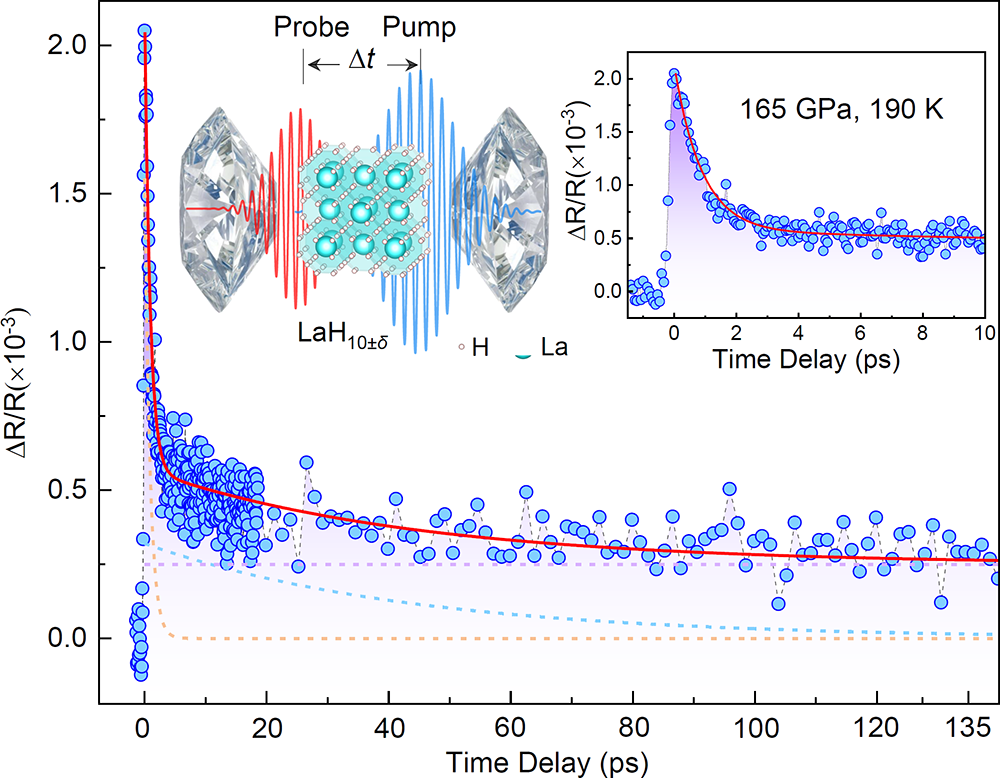High-Pressure Ultrafast Dynamics Evidence Strong Electron-Phonon Coupling Superconductivity in LaH10±δ
Date:12-12-2024 Print
The recent development of on-site in situ high-pressure ultrafast spectroscopy technique has enabled the simultaneous acquisition of precise amplitudes and lifetimes in ultrafast relaxation, making it feasible to investigate superconducting correlated quantum materials. The most significant advancement thus achieved is the capability of experimentally probing the electron-phonon coupling (EPC) strength, superconducting energy gap, and phonon-bottleneck effect under high pressure conditions. Since the discovery of H3S, the most prominent near-room temperature superconductors are clathrate superhydrides, whereby LaH10±δ exhibits a Tc of 250-260K under an ultrahigh pressure of 165-190GPa. However, due to the small sample chamber of a diamond anvil cells (DAC), many advanced experimental tools cannot be employed for detection. This makes it challenging to experimentally obtain key properties such as the EPC strength, microscopic superconducting pairing mechanism, and superconducting energy gap of hydrogen-rich superconductors. To date, direct experimental evidence for the strong EPC in high-Tc superhydride superconductors is still lacking. Meanwhile, the high-pressure ultrafast dynamics of various correlated quantum materials is often difficult to carry out, leaving their non-equilibrium ultrafast dynamics unexplored.
Recently, Prof. ZHAO Jimin Group from Institute of Physics, Chinese Academy of Sciences collaborated with Prof. CHENG Jinguang, Prof. YU Xiaohui, Assoc. Prof. HONG Fang, and Prof. HU Jiangping, all from Institute of Physics, Chinese Academy of Sciences, used the on-site in situ low-temperature variable-temperature ultrahigh-pressure ultrafast spectroscopy instrument to investigate the ultrafast dynamics of clathrate superhydride superconductor LaH10±δ, obtaining the EPC strength and superconducting energy gap of LaH10±δ.
Experimentally, Prof. ZHAO Jimin Group developed an on-site in situ low-temperature high-pressure ultrafast spectroscopy instrument. The research team led by Prof. ZHAO Jimin used it to successfully observe the ultrafast dynamics of LaH10±δ (Fig. 1) at different temperatures (Fig. 2). Simultaneously, they obtained ultrafast quasiparticle relaxation information on both the amplitude and lifetime, and detected the phonon-bottleneck effect near the superconducting transition temperature. Through the analysis of temperature-dependent and fluence-dependent experimental data, they obtained the EPC strength of LaH10±δ as λ=2.58±0.11, the superconducting gap as Δ(0) =53±5meV, the gap ratio as 2Δ(0)/kBTc=5.6, and the gap parameter as ϑ=1.95. The multiple direct experimental evidence obtained, especially the value of λ, all point to that strong EPC may be the cause of near-room-temperature superconductivity in clathrate superhydride compounds. Their investigation advanced the experimental understanding of near-room-temperature superconducting mechanism, boosted the field of high-pressure ultrafast dynamics, and is beneficial for understanding the non-equilibrium ultrafast dynamics and phase transitions of numerous complex material systems under high pressure in the near future.
This study entitled "Ultrafast dynamics evidence of strong coupling superconductivity in LaH10±δ" was recently published in Nature Communications 15, 9683 (2024).
This work was supported by the National Key R&D Program of China, the National Natural Science Foundation of China, the Chinese Academy of Sciences, the Beijing Natural Science Foundation, and the New Cornerstone Investigator Program.

Fig. 1 Typical ultrafast dynamics scanning trace at 165GPa and 190K. (Image by Institute of Physics)

Fig. 2 Low temperature ultrahigh pressure ultrafast QP dynamics of LaH10±δ. (Image by Institute of Physics)
Contact:
Institute of Physics
ZHAO Jimin
Email:jmzhao@iphy.ac.cn
Key words:
Ultrafast dynamics; High-temperature superconductivity; High pressure; Clathrate superhydride; Correlated material
Abstract:
By innovating a sophisticated on-site in situ low-temperature ultrahigh-pressure ultrafast dynamics instrument, they succeeded in directly measuring the EPC strength λ, which provides direct experimental evidence that strong EPC is responsible for the near-room-temperature superconductivity in clathrate superhydrides.


